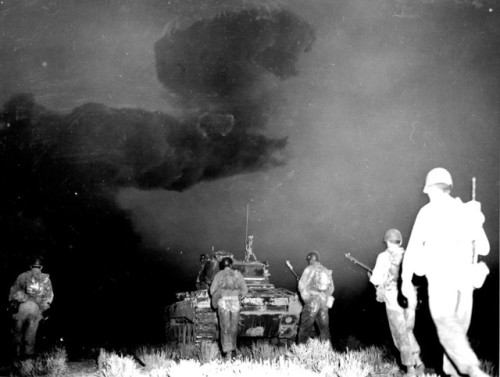Tactical Nuclear Weapon’s Exercises during the Cold WarIt’s quite obvious that nuclear bombs are eff
Tactical Nuclear Weapon’s Exercises during the Cold WarIt’s quite obvious that nuclear bombs are effective weapons for destroying cities, however during the Cold War a question that was on military tacticians minds was as to the effectiveness of nuclear weaponry on the battlefield. The idea of tactical use of nuclear weaponry is to conduct an strike directly against enemy military forces and defenses. The blast would literally blow a hole in the enemy’s defenses which could then be exploited by armored forces and infantry. There were many questions to the efficacy of such a tactic. What effect would a bomb have on enemy fortifications? What are the health hazards of deploying troops in a fallout zone? Would soldiers be able to conduct an offensive maneuver after witnessing a blast 1,000 times brighter than the sun?To answer these questions and more, the US military created a series of tests called the Desert Rock Exercises, which took place in Nye County Nevada. The basic jist of the tests involved detonating a nuclear bomb, either on the ground or in the atmosphere. Once the blast subsided a unit of soldiers would enter the blast zone, sometimes as close as 900 meters from the epicenter. Desert Rock tests I, II, III involved 6,000 soldiers. Desert Rock IV involved 7,400 soldiers, and Desert Rock VI involved 8,000 soldiers, and Desert Rock VII and VIII was conducted with a unit of Marines.Meanwhile on the other side of the world the Soviets determined that they were not to be outdone by the Americans and conducted a exercise of their own. In 1954 the Soviet Army conducted the Totskoye Nuclear Exercise in which 45,000 men, commanded by Field Marshal Georgy Zhukov, marched through the blast zone of a 40 kt nuclear bomb.For someone who is concerned for his or her health, marching through the fallout zone of a nuclear blast is not a very smart idea, and over the coming years the men involved in these experiments suffered from various cancers and related health effects. What’s worse is that these “Atomic Veterans” were sworn to secrecy and were not even permitted to inform their doctors as to the nature of the experiments they had taken part of.In 1979 the National Association of Atomic Veterans was formed with the goal of lobbying congress for healthcare, hazard pay, and other extra benefits. In 1990 President George H.W. Bush signed the Radiation Exposure Act into law, entitling Atomic Veterans and other government employees to special compensation. In 1995 Pres. Bill Clinton officially apologized for the treatment of Atomic Veterans. Finally in 1996 the Nuclear Radiation Secrecy Agreement Act rescinded Atomic Veterans oath of secrecy. -- source link
#history#cold war#atomic veterans#nuclear warfare#atomic weapons#nuclear weapons

